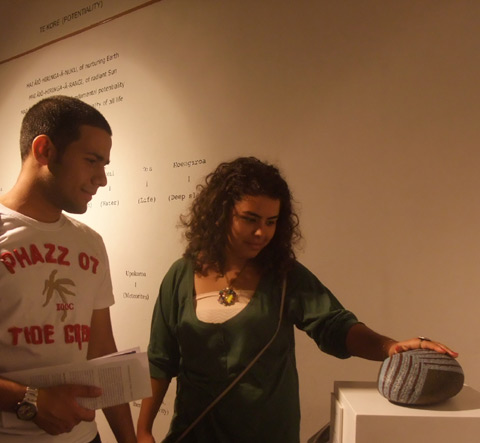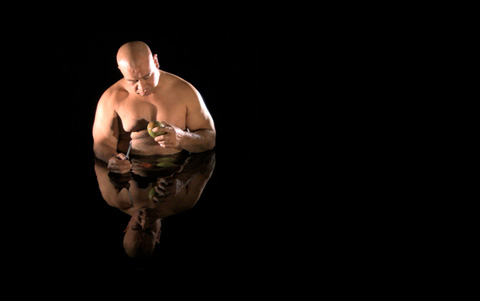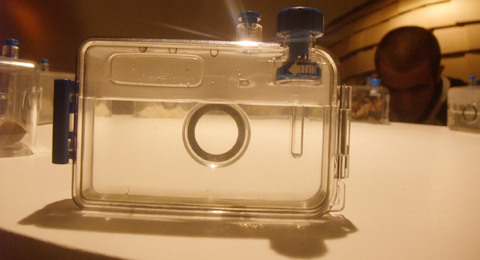“Caught in that sensual music all neglect
Monuments of unaging intellect.” 1
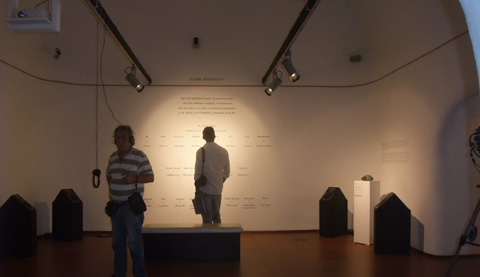
One view of the exhibition, "UNTITLED-second-nature (Te Kore-Rongo-Hungaora)". "Te Taiao Māori" (The Maori World/Environment) text on wall, 2011 by Te Huirangi Waikerepuru (Tribal affiliations: Taranaki, Whānui, Nga Puhi, Taitokerau), flanked by four speakers which are the soundpiece, "Te Kore Street of Breaths" by Sophie Jerram and Dugal McKinnon. On the left is "Mauri Wai Mauri Ora" (Water Energy, Life Energy), Taranaki volcanic stone + acrylic by Jo Tito (Tribal affiliations: Taranaki, Ngāti Pikiao, Tūhourangi-Ngāti Wāhiao). On the floor are one of the star shaped "Photo Astronomy," telescope photographs by Paul Moss.
Previously the annual ISEA events have tended to focus on the two week conference, with exhibited work generally being displayed rather than presented within a conceptual framework (link to the curational concept for ISEA2011). However Aceti also went beyond the confines of the ISEA event in having these ISEA Istanbul exhibitions accepted as an official part of the concurrent Istanbul Biennial
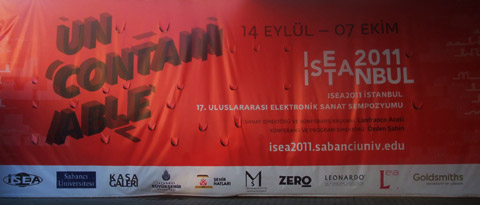
Poster outside the Istanbul Municipal Gallery (Taksim Cumhuriyet Sanat Galerisi), Taksim Square, Istanbul.
It is one thing that this ISEA event was connected with such an international event in the art world but there were also conceptual connections on a number of levels made between the two exhibitions. Aceti used the title “UNCONTAINABLE” as an umbrella term for the independently curated shows, of which the New Zealand-Aotearoa show was part, while the Istanbul Biennial used the umbrella term “UNTITLED” – a reference to the American-Cuban artist, Felix Gonzalez-Torres whose use of this term referred among other things, to the influences of cultural hegemony in naming and categorizing.
While the Istanbul Biennial took a more literal route, also in the way each of the mini-shows were named after a particular work by Gonzalez-Torres, Aceti’s title “UNCONTAINABLE” touches on the ‘in-tangible’ inviting us to ask questions about what is contained to begin with, or how does electronic media ‘contain’ or ‘colonize’ in today’s world. The subtitles for each of the independently curated shows expanded this notion of ‘the ability or inability to contain’ in an organic manner. The New Zealand show subtitled “second-nature” at face value seems to be a reference to othering or alternative nature and in some ways it was, if one’s only point of reference are western cultural values.
Just as Aceti responded to the theme “UNTITLED” and expanded on this by use of the word “UNCONTAINABLE,” the New Zealand curator Ian Clothier’s use of the term ‘second nature’ does likewise as did a number of the works in the show.
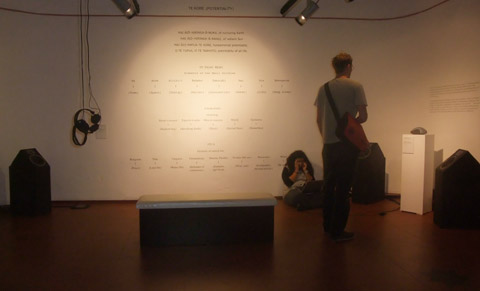
"Te Taiao Māori", text on wall, 2011 by Te Huirangi Waikerepuru (Tribal affiliations: Taranaki, Whānui, Nga Puhi, Taitokerau), flanked by four speakers which are the soundpiece, "Te Kore Street of Breaths" by Sophie Jerram and Dugal McKinnon. On the left is "Mauri Wai Mauri Ora" (Water Energy, Life Energy), Taranaki volcanic stone + acrylic by Jo Tito (Tribal affiliations: Taranaki, Ngāti Pikiao, Tūhourangi-Ngāti Wāhiao).
As you entered the space of curved arches and walls, you encountered a wall of 6 metres of text arranged similiar to a family tree, of words in Maori with English translations. Like a family tree there was an ancestor above branches. This work, “Te Taiao Maori” (The Maori Environment/World) by Huirangi Waikerepuru is a cosmology of what we can feel, hear and taste, a ‘second-nature’ where potentiality is the common ancestor and elements such as life, water, time, interaction, or matter are the offspring.
The wall of text acknowledging the natural world in the context of an international electronic arts show made an immediate impact on anyone there. While one could make analogies with even how programmers programme in levels, modules or processes -a blueprint for the electronic- what Waikerepuru was illustrating was another type of blueprint that functioned like a support or spine for the body of the whole show rather than as a container or means for categorization. Although the text appeared to be like hierarchy, in fact it was an arrangement of three systems beneath each other and the words he used in turn raised questions such as the role of the natural world with the digital.
From this text flowed each of the artworks by the other artists.
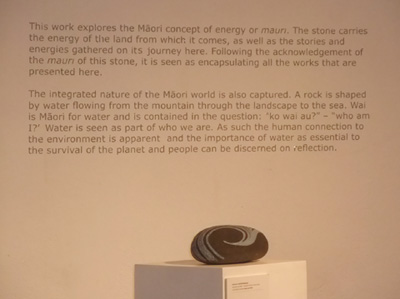
"Mauri Wai Mauri Ora," Taranaki stone, acrylic + text by Jo Tito.
On either side there were speakers for the soundpiece “Te Kore Street of Breaths” by Sophie Jerram and Dugal McKinnon – a continuous audible starting and stopping of breath. Across from the text was Lisa Reihana’s video projection, "Whanaunga" (Relative) with a soundscape by James Pinker, featuring Maui (who brought a number of skills to the world of humanity such as the gift of fire) in the heavens and in water.
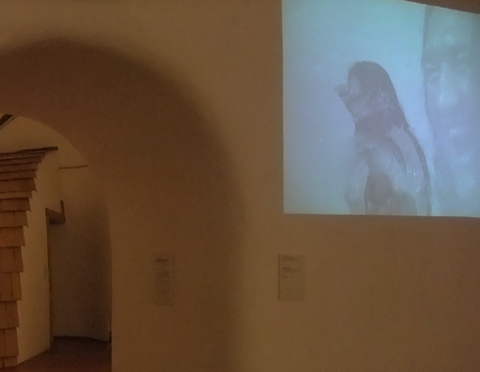
"Whanaunga" (Relative), 2011 digital video by Lisa Reihana (tribal affiliations: Ngāpuhi, Ngāti Hine and Ngāi Tu) and sound by James Pinker. In the background is a detail of "Kāinga a roto," (Home Within) a five screen digital video installation by Sonja van Kerkhoff, Sen McGlinn and Toroa Pohatu.
Reihana’s imagery oscillates between patterns, abstractions and a larger than life, Maui, a figure from the mists of time, as a surfer on the water. The title and surfing associations emphasize the present continuous. The soundscape (by James Pinker) – a rich orchestration of nuances and subtleties – could be read as an interpretation of a nature of continual presence akin to Waikerepuru’s use of the word “Papa-tu-a-nuku” (Revolving Earth) which emphasizes both the everyday, and natural and cultural history in one turn. Julian Oliver’s work “psworld” on the other hand takes a thimble of ‘ordinary’ water to enlarge on the extraordinary. Here a microscope not only facilitates the input for a computer, but nature controls the lifecycle of the computer. For this rendition of his work (see an earlier rendition), the microscope is focussed on protozoa in water which were projected on the wall. Their spontaneous and active movement determined the lifecycle of the (Linux) operating system which ran the computer. When there was too much variation in the movement of the organisms, the programme shut down the computer only to start it up again in order to repeat the process until nature closed it down again. Oliver has used the ‘ps’ function (used on UNIX-like operating systems as a way of showing in coded text what is happening on the computer as a means of testing its own system) to reveal this dependency between one system (the computer) and another (the natural world). In “psworld” coded text appear on the screen over the projection of the protoza informing us of the activity of the protoza as perceived by the computer. It is an exposed computer: vulnerable and dependent on a biological world in flow.
A scattering of star shaped photographs taken with a telescope by Paul Moss were arranged between all of the works mentioned above.
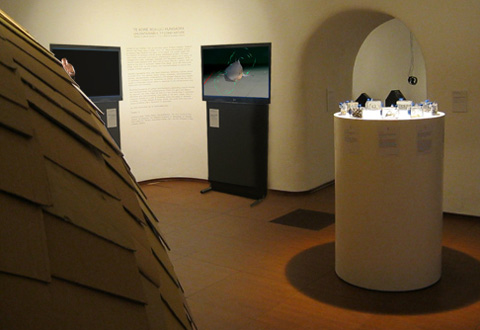
Left to Right: Detail of "Kāinga a roto" (Home Within), a five screen digital video installation inside a curved construction by Sonja van Kerkhoff, Sen McGlinn + Toroa Pohatu; "One man is an island," (obscured) a 6 minute and 40 second high definition video loop by Rachael Rakena (Tribal affiliations: Ngāi Tahu, Ngā Puhi); Text by the curator, Ian Clothier; "Computational Visualization of the Electromagnetic Sensory World of Sharks," 3-d modelling and animation, 2008, by Mike Paulin, and part of "Energy comes from the sun," hardware, software and digital display + 9 waterproof camera cases with texts with texts and selected elements from specific locations along the Whanganui river by Julian Priest.
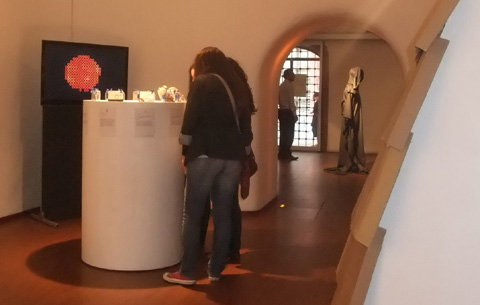
"Energy comes from the sun," hardware, software and digital display + 9 waterproof camera cases with texts with texts and selected elements from specific locations along the Whanganui river by Julian Priest. Beyond is "Tele_Trust," 2009/10, by Karen Lancel + Hermen Maat (The Netherlands, http://www.lancelmaat.nl), in the "UNCONTAINABLE & Untitled" (http://isea2011.sabanciuniv.edu/other-event/uncontainable-untitled) exhibition curated by Lanfranco Aceti + Özden Şahin. On the left is a detail of "Kāinga a roto" (Home Within), a five screen digital video installation inside a curved construction by Sonja van Kerkhoff, Sen McGlinn and Toroa Pohatu.
"Information comes from the sun" by Julian Priest consists of two parts: a circular plinth topped by nine transparent camera containers accompanied by a text placed on the plinth below each camera, and a visualization of solar power.

"Energy comes from the sun" by Julian Priest in front of "Kāinga a roto (Home Within) by Sonja van Kerkhoff, Sen McGlinn and Toroa Pohatu.
Waikerepuru’s words give equal weight to the conceptual and the phenomenological, whereas Priest’s approach seems to be about diverse systems of ‘show and tell’ which seemed to be lost on most of the public. This was a work that needed some form of explanation for a public unfamiliar with New Zealand. A statement that all these locations were along the same river (The Whanganui River) would then help people to see the connections between location, forms of explanation (some texts were poetic, some encyclopedic) and the objects contained within. It was also hard to see the connection between the visualization of solar power in the form of changing orange zeros and the camera containers. The display was intended to correlate with the intensity of the sun’s energy in real-time. Perhaps the disparities, the contrasts and differences were the intent of the work. The title relates to the display of orange zeros while the various elements inside the cameras it could be argued, are the result of life, made possible by our sun.
However the aspect of nature which seems to dominate in this exhibition is that of water. In the final work in the show, “Kāinga a roto” (Home Within),” a five screen digital video installation inside a curved construction by Sonja van Kerkhoff, Sen McGlinn + Toroa Pohatu, videos and soundscapes present rivers, the sea, waterfalls and rain as a recurring motif. And water flows throughout the show either via words, elements it has shaped (such as the sea worn stone) or visually in the various videos. Perhaps what is ‘second nature’ is not so much wai-rua, literally the second current, but that materiality (first nature) is more fluid than one might imagine.
The quotation and reference in the title comes from the poem,
Sailing To Byzantium by W.B. Yeats
Links:
Intercreate.org, which lists all artists and some images.
The ISEA webpage for this exhibition

